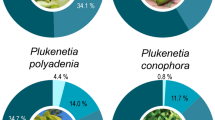Abstract
Five varieties of Amaranthus cruentus were planted in 3 localities at different altitudes above sea level. They were subjected to equivalent agronomic practices and harvested at 120–130 days. The seeds were removed and dried to 12% moisture. The seeds from each variety were analyzed for total fat, palmitic, stearic, oleic and linolenic acids and squalene contents. Oil content varied from 5.83 to 7.13%, palmitic acid from 17.06 to 21.35%, stearic acid from 3.05 to 3.80%, oleic acid from 20.26 to 32.01% and linoleic acid from 33.52 to 43.88%. The values for oil and fatty acid contents were similar to those found in the literature. The differences in the analytical values of the present study were not statistically significant for variety or for location.
Squalene content varied from 2.26 to 5.94% of the oil. This variability is similar to that reported previously by other workers. Statistical analysis showed significant difference for localities but not for varieties. It is suggested that environmental conditions, such as temperature and water availability, may lead to a greater accumulation of squalene in the grain.
Similar content being viewed by others
References
Segura-Nieto M, Barba de la Rosa AP, Paredes-López O (1994) Biochemistry of Amaranth Proteins. Chap. 5 In: Amaranth, Biology, Chemistry and Technology. Ed. O. Paredes-López, CRC, Press, Inc. Boca Ratón, Florida 33931.
Bressani R (1994) Composition and Nutritional Properties of Amaranth. Chap. 10. In: Ama-ranth, Biology, Chemistry and Technology. Ed. O, Paredes-López CRC Press Inc., Boca Ratón, FLDRIDA 33931.
Becker R, Wheeler EL, Lorenz K, Stafford AE, Grasjean OK, Betschart AA, Saunders RM (1981) A compositional study of Amaranth Grain. J Food Sci 46(4): 1175–1180.
Bressani R, Gonzalez JM, Züniga J, Breuner M, Elias LG, (1987) Yield and selected chemical composition and nutritional value of 14 selections of amaranth grain representing four species. J Sci Food Agric 38: 347–356.
Becker R (1989) Preparation, composition and nutritional implications of amaranth seed oil. Cereal Foods World 34(11): 950–953.
Mehlenbacker VC (1979) Analysis de grasas y aceites. Enciclopedia de la Química Industrial. Tomo 6. Ed. Urmo España.
Ayorinde FO, Ologund MO, Nana EY, Bernard BN, Apolabi OA, Oki OL, Shepard RL (1989) Determination of fatty acid composition of amaranthus species. J Am Oil Chem Sci 66(12): 1812–1816.
Bertoni MH, Gomez RG, Caltaneo P, Covas G (1989) Estudios sobre semillas de especies americanas de amarantus. I. Aceite de A. caudatus, A. cruentus y A. mantegazzianus. An Asoc Quim Argent 72(4): 391–397.
Lyon CK, Becker R (1987) Extraction and refining of oil from amaranth seed. J Am Oil Chem Sci 64: 233–236.
Singhal RS, Kulkarni PR (1990) Effect of puffing on oil characteristics of amaranth (Raigera) seeds. J Am Oil Chem Sci 67(12): 952–954.
Singhal RS, Kulkarni PR (1988) Amaranth oils: A new source of squalene Amaranth Newsletter No. 3. P. 7–8 (September).
AOAC (1984) Official Methods of Analysis of the Association of Official Analytical Chemists. 14th. Ed. Washington, DC: United State.
Kigel J (1994) Development and Ecophysiology of Amaranth. Chap. 4 in Amaranth: Biology, Chemistry and Technology. Ed. O. Paredes-López CRC Press Inc., Boca Ratón Florida. US.
Author information
Authors and Affiliations
Rights and permissions
About this article
Cite this article
Berganza, B.E., Moran, A.W., Rodríguez, G.M. et al. Effect of variety and location on the total fat, fatty acids and squalene content of amaranth. Plant Foods Hum Nutr 58, 1–6 (2003). https://doi.org/10.1023/B:QUAL.0000041143.24454.0a
Issue Date:
DOI: https://doi.org/10.1023/B:QUAL.0000041143.24454.0a



